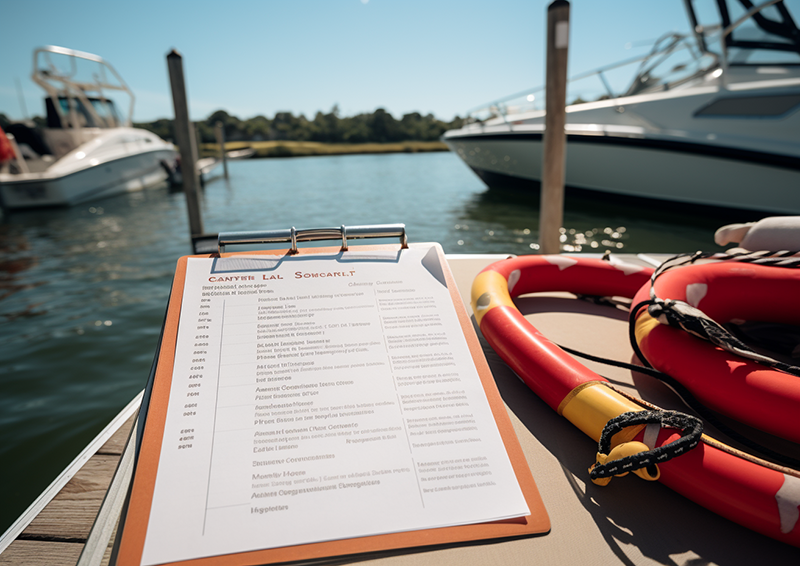Whether you’re planning a leisurely family outing or embarking on an exciting solo adventure, boat safety should always be a top priority. Before setting sail, it’s essential to create a comprehensive pre-departure checklist to ensure a safe and enjoyable boating experience for everyone on board. In this article, we will guide you through the key elements of a pre-departure checklist to help you navigate the waters with confidence.
1️⃣ Safety Equipment: Ensure that your boat is equipped with the necessary safety gear. Here are some essential items to include:
- Personal Flotation Devices (PFDs): Have an adequate number of Coast Guard-approved PFDs on board, including different sizes for adults, children, and pets. Make sure they are easily accessible and in good condition.
- Throwable Flotation Device: Keep a throwable flotation device, such as a lifebuoy or a cushion, within reach.
- Fire Extinguishers: Verify that the appropriate type and number of fire extinguishers are on board, in compliance with local regulations. Inspect them regularly to ensure they are fully charged.
- Visual Distress Signals: Carry approved visual distress signals, such as flares or signal flags, in case of emergencies.
- Sound-Producing Device: Have a functioning horn, whistle, or bell to signal your presence in foggy conditions or low visibility.
- First Aid Kit: Keep a well-stocked first aid kit on board to address minor injuries or medical emergencies.
- Navigation Lights: Ensure that all navigation lights are in working order, especially if you plan to boat at dawn, dusk, or during nighttime.
2️⃣ Communication and Documentation: Stay prepared and connected while out on the water:
- Cell Phone and Charger: Carry a fully charged cell phone in a waterproof case or bag to contact emergency services if needed.
- Marine Radio: Invest in a marine VHF radio for reliable communication with other boaters and emergency services. Familiarize yourself with its usage before departure.
- Float Plan: Inform a trusted person ashore about your boating plans, including your itinerary, estimated return time, and contact information. Regularly update them if there are any changes.
- Boating License and Registration: Ensure that you have the appropriate licenses and boat registration documents on board, as required by local authorities.
3️⃣ Mechanical and Navigational Checks: Prioritize the operational readiness of your boat:
- Fuel: Check the fuel levels and ensure that you have enough for your planned journey, including extra reserves for unexpected delays.
- Engine and Propellers: Inspect the engine for any visible signs of damage or leaks. Test the controls, steering, and propellers to ensure they are functioning properly.
- Bilge Pump: Ensure the bilge pump is in working order to remove water from the boat’s hull, helping to prevent flooding.
- Navigation Aids: Verify that your navigational instruments, such as GPS, compass, and depth sounder, are functioning correctly.
- Weather Check: Check the weather forecast and be aware of any impending changes that could affect your boating plans. Avoid boating in severe weather conditions.
4️⃣ Safety Procedures and Knowledge: Prepare yourself and your passengers for a safe boating experience:
- Boating Safety Course: Consider taking a boating safety course to enhance your knowledge of boating rules, navigation, and emergency procedures.
- Safe Loading: Ensure that your boat is not overloaded with passengers or equipment, as it can affect stability and safety.
- Passenger Briefing: Familiarize all passengers with the location and usage of safety equipment, emergency procedures, and any boat-specific rules.
- Alcohol and Substance Awareness: Avoid the consumption of alcohol or substances that may impair your judgment or reflexes while operating a boat. Designate a sober skipper.
- Children and Pets: Implement appropriate safety measures for children and pets on board, such as properly fitting PFDs and secure areas to prevent accidental falls overboard.
Remember, this pre-departure checklist is a starting point. Tailor it to your specific boating activities, the size of your vessel, and local regulations. Regularly inspect and maintain your boat and safety equipment to ensure they are in optimal condition.
By prioritizing safety and being well-prepared, you can enjoy a fantastic boating experience while minimizing risks. Keep in mind that the safety of yourself, your passengers, and others on the water should always be your utmost concern.
Smooth sailing and safe adventures! ⚓🌊🛥️
#BoatSafetyFirst #PreDepartureChecklist #StaySafeOnTheWater #EssentialSafetyGear #CommunicationOnBoard #MechanicalReadiness #KnowTheRules #SafeBoatingPractices #BePreparedAtSea #EnjoySafeAdventures
